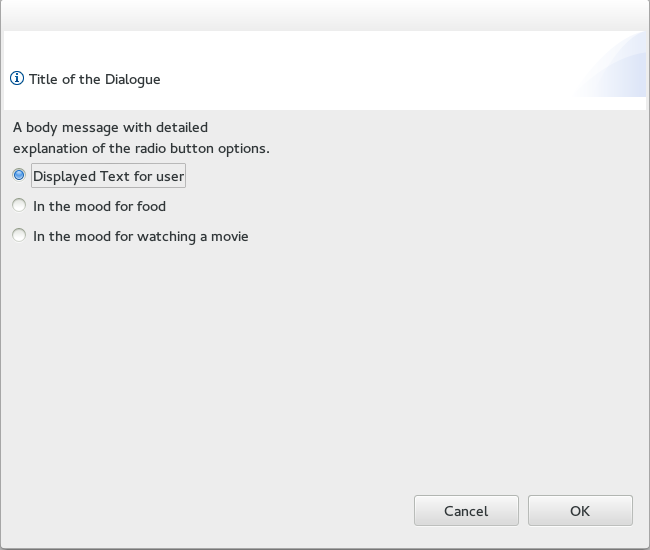Notice: This Wiki is now read only and edits are no longer possible. Please see: https://gitlab.eclipse.org/eclipsefdn/helpdesk/-/wikis/Wiki-shutdown-plan for the plan.
Eclipse Plug-in Development FAQ/TitleAreaDialogWithRadioButtons
Overview
This is an example of how easy it is to extend the Title Area Dialog to match your needs.
Title Area Dialog With Radio Buttons
This is useful if you need to ask the user to choose one of multiple options instead of a 'yes/no'.
It also looks cleaner than having multiple buttons at the bottom of the screen.
When instantiated, it looks like this:
Source code
/******************************************************************************* * Copyright (c) 2014 Red Hat, Inc. * All rights reserved. This program and the accompanying materials * are made available under the terms of the Eclipse Public License v1.0 * which accompanies this distribution, and is available at * http://www.eclipse.org/legal/epl-v10.html * * Contributors: * lufimtse : Leo Ufimtsev lufimtse@redhat.com *******************************************************************************/ package org.eclipse.linuxtools.profiling.ui; import java.util.ArrayList; import java.util.List; import java.util.Map.Entry; import org.eclipse.jface.dialogs.TitleAreaDialog; import org.eclipse.swt.SWT; import org.eclipse.swt.layout.GridData; import org.eclipse.swt.layout.GridLayout; import org.eclipse.swt.widgets.Button; import org.eclipse.swt.widgets.Composite; import org.eclipse.swt.widgets.Control; import org.eclipse.swt.widgets.Label; import org.eclipse.swt.widgets.Shell; /** <h1> Dialogue with radio options. <h1> * <p> This is useful if you need to ask the user to choose one of multiple options instead of a 'yes/no'. <br> * It also looks cleaner than having multiple buttons at the bottom of the screen. </p> * * <p> * Please see the <a href="https://wiki.eclipse.org/File:TitleAreaDialogWithRadioButtonsExample.png">Screen shot</a> * to see what it looks like.</p> * * <p> Please see <a href="https://wiki.eclipse.org/Eclipse_Plug-in_Development_FAQ/TitleAreaDialogWithRadioButtons""> wiki page </a> * for additional details & example.</p> * * @author lufimtse : Leo Ufimtsev lufimtse@redhat.com * */ public class TitleAreaDialogWithRadioButtons extends TitleAreaDialog { private String selectedButton; private String title, bodyMsg; private int msgType; //IMessageProvider private List<Entry<String, String>> userButtonList; // ButtonID , Button Label private List<Button> widgetButtonList; /** * <h1> Construct dialogue </h1> * <p> Specify paramaters, then use open. </p> * * <p> Please see <a href="https://wiki.eclipse.org/Eclipse_Plug-in_Development_FAQ/TitleAreaDialogWithRadioButtons""> wiki page </a> * for additional details & example.</p> * * @param parentShell - Parent Shell * @param title - Title of the dialogue. * @param bodyMsg - Body message of the dialogue. * @param userButtonList - A list of SimpleEntry<String,String> mapping ButtonIDs and their visable text. * (see <a href="https://wiki.eclipse.org/Eclipse_Plug-in_Development_FAQ/TitleAreaDialogWithRadioButtons#Example_usage"> wiki example </a> for details) * @param msgType - 'IMessageProvider.INFORMATION ' Can be one of: NONE ERROR INFORMATION WARNING */ public TitleAreaDialogWithRadioButtons( Shell parentShell, String title, String bodyMsg, List<Entry<String, String>> userButtonList, int msgType) { //for type see: IMessageProvider super(parentShell); // Set the Buttons that will be used listed. this.userButtonList = userButtonList; //Set labels. this.title = title; this.bodyMsg = bodyMsg; //set type this.msgType = msgType; // avoid help button poping up. this.setHelpAvailable(false); selectedButton = null; } /** Dialogue constructor */ @Override public void create() { super.create(); //The 'Message' of a TitleArea dialogue only spans 1-2 lines. Then text is cut off. //It is not very efficient for longer messages. //Thus we utilize it as a 'title' and instaed we appeng a label to act as body. (see below). setMessage(this.title, this.msgType); //$NON-NLS-1$ //setTitle(); //not used. //Set the size of the dialogue. //We avoid hard-coding size, instead we tell it to figure out the most optimal size. //this.getShell().setSize(650, 550); //Hard-Coded = bad. this.getShell().setSize(getInitialSize()); } /** Return the buttonID of the button that the user selected if he pressed ok. * * @return ButtonID of selected button. */ public String getSelectedButton() { return selectedButton; } @Override protected Control createDialogArea(Composite parent) { Composite area = (Composite) super.createDialogArea(parent); Composite container = new Composite(area, SWT.NONE); container.setLayoutData(new GridData(GridData.FILL_BOTH)); GridLayout layout = new GridLayout(1, false); container.setLayoutData(new GridData(SWT.FILL, SWT.FILL, true, true)); container.setLayout(layout); //Append a label to act as message body Label label = new Label(container, 0); label.setText(this.bodyMsg); //----- Add Radio buttons to dialogue. widgetButtonList = new ArrayList<>(); int ButtonCount = 1; for (Entry<String, String> usrbutton : userButtonList) { Button tmpButton = new Button(container, SWT.RADIO); tmpButton.setText(usrbutton.getValue()); if (ButtonCount == 1) { tmpButton.setSelection(true); //Make first button be auto-selected. ButtonCount++; } widgetButtonList.add(tmpButton); } return area; } // save content of the Text fields because they get disposed // as soon as the Dialog closes protected void saveInput() { //Figure out which button was selected and set 'selectedButton' to it's key. for (int i = 0; i < widgetButtonList.size(); i++) { if (widgetButtonList.get(i).getSelection()) { selectedButton = userButtonList.get(i).getKey(); } } } /** Called when the ok button is pressed */ @Override protected void okPressed() { saveInput(); // save input. super.okPressed(); // close dialogue } }
Example usage
// //-- Required imports. (some overlap with awt, use jface once): // import org.eclipse.jface.dialogs.IMessageProvider; // import org.eclipse.jface.window.Window; // import java.util.AbstractMap.SimpleEntry; // import java.util.ArrayList; // import java.util.List; // import java.util.Map.Entry; //--- Declare a list for the buttons. List<Entry<String,String>> buttonList = new ArrayList<>(); //--- Add buttons: buttonList.add(new SimpleEntry<String,String>("ButtonID", "Displayed Text for user")); //Ananomous add. buttonList.add(new SimpleEntry<String,String>("Food", "In the mood for food")); buttonList.add(new SimpleEntry<String,String>("Movie", "In the mood for watching a movie")); //--- Set Dialogue options. String title = "Title of the Dialogue"; String body = " A body message with detailed explanation of the radio button options \n" + "It can be stretched over many lines. The Dialogue resizes itself."; int msgType = IMessageProvider.INFORMATION; //Can be one of: NONE ERROR INFORMATION WARNING Shell myShell = shell; //Usually available, or use 'new Shell()' if you don't have one at hand. //--- Instantiate & open the dialogue. TitleAreaDialogWithRadioButtons myDialog = new TitleAreaDialogWithRadioButtons(shell, title, body, buttonList, msgType); int retVal = myDialog.open(); //Handle dialogue outcome. switch (retVal) { case Window.OK: //Avoid using generic '1' and '0' as it's confusing. Use defined constants as shown. System.out.println("You selected option: " + myDialog.getSelectedButton()); break; case Window.CANCEL: System.out.println("You clicked cancle"); break; default: System.out.println("Unexpected closure of dialogue."); break; }

